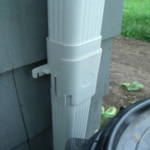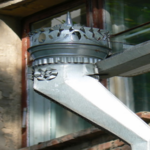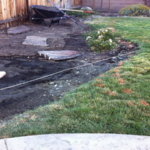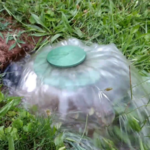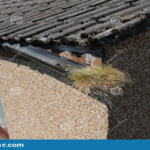The answer to this question may differ depending on location, but typically, gutters drain water into a storm drain or a dry well. Storm drains lead directly into surface water bodies such as lakes, rivers, or oceans. Dry wells are pits that allow water to percolate into the ground, where it will eventually evaporate or be taken up by plants.
Do downspouts drain into sewer?
There are a few things to consider when answering this question. First, it depends on the location of the downspout. If the downspout is located near a sewer line, then it is likely that the water will drain into the sewer. However, if the downspout is located away from a sewer line, then the water will likely drain into a storm drain or a dry well. Second, it depends on the type of downspout. Some downspouts are designed to drain into a sewer, while others are designed to drain into a storm drain or a dry well. Finally, it depends on the municipality. Some municipalities require that downspouts drain into a sewer, while others do not.
What happens to gutter water?
The water that runs off of your roof and into your gutters is typically referred to as gutter water. This water is usually channeled away from your home through a system of gutters and downspouts. Depending on how your gutters are set up, the water may be directed into a storm drain, a dry well, or simply away from your foundation.
Gutter water is generally not considered to be potable, or safe to drink. This is because it can contain a variety of contaminants, including leaves, twigs, and dirt. Additionally, gutter water can pick up pollutants from the atmosphere, such as bird droppings, car exhaust, and pollen. If you were to drink gutter water, you would likely experience gastrointestinal distress, as well as other health problems.
Should downpipes go into the ground?
There are a few schools of thought when it comes to downpipes and whether or not they should go into the ground. Some believe that downpipes should be buried in the ground in order to avoid any potential damage from severe weather or other hazards, while others believe that keeping the downpipes above ground is the best way to go. There are pros and cons to both methods, and ultimately it is up to the homeowner to decide what is best for their home.
Burying downpipes in the ground can help to protect them from damage during severe weather events, such as hurricanes or tornadoes. If the downpipes are not buried, they are more likely to be damaged by high winds or flying debris. However, buried downpipes can be more difficult to repair if they do become damaged, and they may be more susceptible to clogging from debris or roots.
Keeping downpipes above ground is generally considered to be the easier option, as they are more accessible for repairs and maintenance. Additionally, above ground downpipes are less likely to become clogged, as debris can more easily fall away. However, without the protection of being buried, above ground downpipes are more vulnerable to damage from severe weather or other hazards.
Where should gutter downspouts go?
There is no definitive answer to this question as it depends on a number of factors, such as the size and layout of your home, the climate you live in, and your personal preference. However, there are a few general guidelines you can follow when deciding where to place your gutter downspouts.
First, it is generally best to place downspouts away from areas where people congregate, such as patios, decks, and walkways. This will minimize the risk of someone being hit by a stream of water coming from the downspout.
Second, you’ll want to consider the amount of rainfall your area receives. If you live in an area with heavy rains, you’ll want to make sure your downspouts are placed in an area where the water can drain away quickly and won’t cause flooding.
Finally, you’ll want to take into account the appearance of your home when deciding where to place your downspouts. If you want them to be hidden from view, you can place them behind shrubs or other landscape features. If you want them to be more visible, you can place them near the corners of your home.
Where does a house downpipe water go?
A downpipe is a pipe that is used to take water from the gutter of a building and drain it away from the base of the structure. The water that is collected in the gutter is typically channeled into the downpipe and then directed away from the house or building through a series of underground pipes. The water that is collected in the gutters is typically channeled into the downpipe and then directed away from the house or building through a series of underground pipes.
Where should downspouts drain to?
There are a few things to consider when deciding where to drain your downspouts. One is whether you want the water to flow away from your foundation to prevent water damage. If so, you’ll want to make sure the downspouts are draining at least 3-4 feet away from the foundation. Another thing to consider is whether you have a backyard that slopes towards your house. If so, you’ll want to make sure the downspouts are draining away from the house so the water doesn’t pool up against the foundation.
Should a downspout drain onto roof?
No, a downspout should not drain onto a roof. The weight of the water can damage the shingles and over time will cause leaks in the roof. It is best to drain the water into a gutter or away from the foundation of the house.
Can downspouts be connected to sewer?
Downspouts can be connected to sewer lines, but there are a few things to consider before doing so. First, check with your local municipality to see if there are any regulations or ordinances in place regarding the connection of downspouts to sewer lines. Second, consider the potential for increased water flowing through the sewer line if all of the downspouts from your home are connected. This could potentially overload the sewer line and cause backups or other problems. Finally, make sure that the connection is made properly and that the downspouts are drained away from the foundation of your home to avoid any water damage.
Can rain water be drained into the sewer system?
It is possible to drain rain water into the sewer system, but it is not recommended. The sewer system is not designed to handle large volumes of water and it could lead to flooding and other problems. Additionally, the rain water would likely contain pollutants that would end up in the sewer system.
Bottom Line
The water from your gutters will flow into a drain pipe, which will then empty into a storm sewer or a dry well. The storm sewer will carry the water away from your home, and the dry well will allow the water to seep into the ground.





